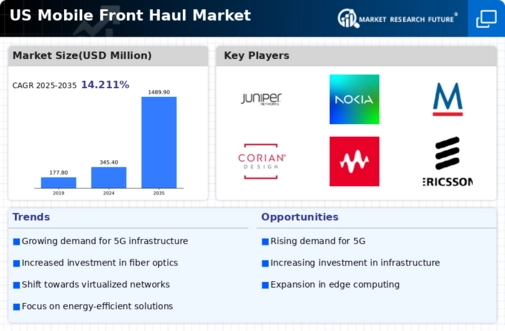Increased Investment in 5G Infrastructure
The ongoing rollout of 5G networks is significantly impacting the mobile front-haul market. With the US government and private sector investing heavily in 5G infrastructure, the demand for efficient mobile front-haul solutions is expected to rise. The mobile front-haul market is projected to see investments exceeding $20 billion by 2025, as operators upgrade their networks to support the higher data rates and lower latency associated with 5G. This investment not only enhances network performance but also drives innovation in mobile front-haul technologies, creating new opportunities for growth and development within the industry.
Rising Demand for High-Speed Connectivity
The mobile front-haul market is experiencing a surge in demand for high-speed connectivity, driven by the increasing reliance on mobile data services. As consumers and businesses alike seek faster internet speeds, the need for robust mobile front-haul solutions becomes paramount. In the US, mobile data traffic is projected to grow at a CAGR of 25% through 2025, necessitating advanced infrastructure to support this growth. This demand is further fueled by the proliferation of IoT devices, which require seamless connectivity. Consequently, service providers are investing heavily in mobile front-haul technologies to enhance their network capabilities, ensuring they can meet the evolving needs of their customers. The mobile front-haul market is thus positioned for significant growth as it adapts to these changing demands.
Growing Need for Enhanced Network Reliability
As mobile services become increasingly critical to daily life, the need for enhanced network reliability is more pronounced than ever. The mobile front-haul market is responding to this demand by developing solutions that ensure consistent and reliable connectivity. In the US, service outages can lead to significant financial losses, prompting operators to invest in more resilient mobile front-haul systems. The mobile front-haul market is thus focusing on redundancy and failover mechanisms to minimize downtime and maintain service quality. This trend is likely to drive further innovation and investment in the sector, as operators strive to meet customer expectations for uninterrupted service.
Technological Advancements in Network Infrastructure
Technological advancements are playing a crucial role in shaping the mobile front-haul market. Innovations such as software-defined networking (SDN) and network function virtualization (NFV) are enabling more efficient and flexible network management. These technologies allow operators to optimize their mobile front-haul networks, reducing latency and improving overall performance. In the US, the adoption of these technologies is expected to increase, with a projected market value of $10 billion by 2026. As operators seek to enhance their service offerings and reduce operational costs, the mobile front-haul market is likely to benefit from these advancements, leading to more competitive and resilient networks.
Regulatory Initiatives Promoting Infrastructure Development
Regulatory initiatives in the US are increasingly promoting infrastructure development, which is beneficial for the mobile front-haul market. Government policies aimed at enhancing broadband access and reducing barriers to deployment are encouraging investments in mobile front-haul technologies. These initiatives are expected to facilitate the expansion of network infrastructure, particularly in underserved areas. The mobile front-haul market stands to gain from these regulatory changes, as they create a more favorable environment for investment and innovation. As a result, operators are likely to accelerate their deployment of mobile front-haul solutions, contributing to the overall growth of the market.

















Leave a Comment